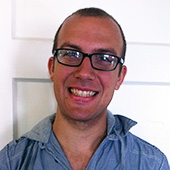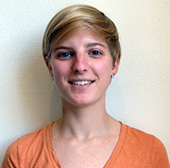Summer Research Internships for Undergraduates
 2-D magnetotelluric investigation of fluid controls involved in episodic tremor and slip in the Cascadia subduction zone
2-D magnetotelluric investigation of fluid controls involved in episodic tremor and slip in the Cascadia subduction zoneEpisodic tremor and slip (ETS) occurring in the Cascadia subduction zone is characterized by periodic retrograde displacements occurring at the interface between the cold, locked upper plate interface and the slow-slip deep, hot plate interface. There are currently several hypotheses regarding the mechanisms controlling ETS, and while there is still debate as to what model best describes this phenomenon, most current hypotheses involve fluid at the plate interface. There are many unanswered questions regarding the role and source of fluids in ETS. While answering these questions can be difficult due to the depths at which ETS occurs, 25-45 km, electromagnetic geophysical methods offer the best method for fluid identification at the plate interface, in particular long-period magnetotellurics (MT) since electrical conductivity of crustal rocks is highly sensitive to the presence and interconnectivity of fluids involved in ETS. As the first stage of a large scale 3-D MT model of the Cascadia subduction zone, a 2-D West to East transect across southwestern Washington was analyzed to provide initial results and interpretations. The West-East transect was obtained by 8 long-period MT stations with a spacing of ~15 km. The results of the 2-D model are expected to illuminate possible fluid controls involved with ETS, furthering our understanding of this relatively newly-discovered tectonic process. With further understanding of the mechanisms controlling ETS, it is possible that better understanding of mega-thrust earthquakes will follow.
 Development of an artificial methane seep and its influence on aerobic methanotroph proliferation
Development of an artificial methane seep and its influence on aerobic methanotroph proliferationMethane seeps and the microbial methanotroph communities that sequester methane from those seeps play a major role in the methane biogeochemical cycle, but may be susceptible to the effects of changing atmospheric and oceanic conditions. Although thought to exist in myriad geological environments around the world, methane seeps and its biological communities as they are forming are difficult to study. The creation of artificial methane seeps in ocean sediments may act as an accessible alternative for further understanding the patterns and timescale at which methanotrophs may proliferate in newly formed methane seeps and sequester methane that would otherwise diffuse into the ocean and atmosphere. In order to understand the conditions and timescale aerobic methanotroph can proliferate, artificial seep systems were create in both a controlled laboratory environment and in situ site at Yaquina Bay, Oregon. Samples were tested for the characteristic aerobic methanotroph biomarker, 16:1(n-6) fatty acid, by gas chromatography at increasing depths. Results indicate that aerobic methanotrophs proliferated with highest yields at the point source of methane introduction in both the laboratory and in situ experiments. Methane-treated cores illustrated some methanotrophs throughout the sediment column, but quantities varied between replicate cores at different depths. However, no aerobic methanotrophs were detected in control cores, indicating that the introduction of methane must have induced aerobic methanotrophs recruitment. Thus, aerobic methanotrophs can proliferate within a 1-3 week time frame in newly formed methane seeps, results that support the use of artificial methane seeps as an accessible tool to study methane seep systems.
 Relocating earthquakes on the Oregon continental margin
Relocating earthquakes on the Oregon continental marginThe Cascadia subduction zone experiences a low level of seismicity, though the fault has the potential to create large megathrust earthquakes (M>9). Since 2003, earthquake activity on the Oregon continental margin has been primarily limited to two persistent clusters between the latitudes of 44.3 and 44. 7° N. Hypocenters for these events reported by the Pacific Northwest Seismic Network (PNSN) are generally within the mantle of the subducting plate. However, more detailed studies that incorporate local crustal structure from active source experiments, ocean-bottom seismometer (OBS) data, and waveform modeling suggest that they are located on or near the plate boundary and may be associated with subducted seamounts. Since the beginning of the Cascadia Initiative (CI), 24 microearthquakes have been reported by the PNSN in this region, including 8 events with M>2.75. We are using the CI OBS data to relocate these events in order to improve resolution of hypocentral depth. Most of these events can be associated with one of the previously identified clusters. However, on January 25, 2013, four small earthquakes (mag. 2.7-3.4) occurred in a cluster that was reported by PNSN to be ~20 km west of the previously identified clusters at a depth of 35-40 km. The National Earthquake Information Center (NEIC) reported a location for the largest of these events that was 20 km west of the PNSN location at 6 km depth. P and S waves from these four earthquakes were well recorded on three of the OBSs recovered during Cascadia Initiative cruise AT26-02 in late June 2013. One of the OBSs was within 6 km of the epicenters. The relocated epicenters are close to those reported by PNSN but the revised depths are 12-16 km for three events and <10 km for one event. We conclude that these events represent a new cluster of activity associated with plate boundary heterogeneity.
 Investigating Labrador Sea warmth in the Pliocene with Eirik Drift sediments
Investigating Labrador Sea warmth in the Pliocene with Eirik Drift sedimentsWith the increasing threat of anthropogenic climate change, the Pliocene is growing relevant to the modern day, as it is the last recorded time that atmospheric CO2 may have reached 400 ppm. The North Atlantic is a crucial element to the albedo feedback, ocean circulatory system, and various other components of the climate system, so a better understanding of how the area responds to a warming climate is crucial to understand the effects of anthropogenic climate change in the near future. IODP Site U1307, located off of the southern tip of Greenland on the Eirik Drift in the Labrador Sea, records a significant excursion in magnetic susceptibility during the Mid-Pliocene Optimum (~3.3-3.0 Ma), which could reflect deglaciation of Greenland in response to rapid warming. To understand how the Greenland Ice Sheet (GIS) and Labrador Sea responded to altered levels of CO2 during the Pliocene, I performed grain size analysis and constructed a δ18O record of the planktonic foraminiferal species Globigerina bulloides. These data will provide insight into response of the Labrador Sea and the GIS to mid-Pliocene atmospheric CO2 concentrations that were similar to present day levels.
 The regulation of magnesium in shell formation of larval Pacific oyster Crassostrea gigas
The regulation of magnesium in shell formation of larval Pacific oyster Crassostrea gigasThe principle component of bivalve larval shell is aragonite, a polymorph of calcium carbonate. The ratio of magnesium to calcium in calcium carbonate can influence the stability of the mineral, a possible risk for bivalve larvae as the effects of ocean acidification progress. We have begun an investigation into the regulation of Mg/Ca in bivalve larval shell. Components of this investigation include the development of a standard method for the removal of organic tissue from bivalve larvae, analysis of Mg/Ca in larval shell throughout early life history, and development of a method for the isolation of the insoluble organic matrix from larval shell.
 Interannual sandbar morphodynamics within the Columbia River littoral cell
Interannual sandbar morphodynamics within the Columbia River littoral cellExamining nearshore sandbar behavior is highly relevant to understanding past and predicting future coastal change because of the role that these morphologic features play in regional sand budgets. The alongshore variability of interannual sandbar morphodynamics in the Columbia River Littoral Cell (CLRC) was investigated using nearshore bathymetric and subaerial beach topographic data. Both existing and new high resolution coastal change data were used to evaluate bar geometry evolution in the Long Beach subcell of the CRLC. Parameters such as bar crest position from the shoreline, bar crest depth, and bar height have been extracted from the dataset to evaluate both spatial and temporal trends in bar migration. The analysis focused on characterizing differences in migration rates and return periods of bars within the subcell. For the study area of the Long Beach subcell, bar crest depth strongly correlated to cross-shore position and return periods of bars were found to be approximately three years on average, with bar migration rates differing largely depending on relative seaward position in the nearshore zone.
 Analysis of internal tides in the Bering Sea from a high-resolution numerical model
Analysis of internal tides in the Bering Sea from a high-resolution numerical modelInternal tides in the Bering Sea are an understudied process that can directly affect the biology of the Bering Sea Shelf by altering vertical mixing and cross shelf exchange. To understand the impact of the internal tides it is important to determine the spatial distribution of generation and dissipation along with the propagation pathways. Analysis of fields from a high-resolution numerical model of the Bering Sea are used to determine the magnitude of the internal tides, the depth-integrated baroclinic tidal energy flux (EF), the topographic energy conversion (TEC), and the residual term (TEC-div(EF)). Locations with high TEC correspond to increased internal tide creation, and occur along the Bering shelf edge and along the Aleutian Islands, particularly in the vicinity of Amukta Pass. The internal tides appear to propagate onto the shelf with local EF values reaching several hundred W/m. This energy dissipates over about 100 km shoreward of the shelf break. Internal tides appear to play a role in the degradation of the Bering Sea cold pool, exhibiting fine-scale structures in EF on the scale of 10 W/m coincident with patterns of temperature variation in the cold pool.
 Are Ag concentrations in marine sediments related to sedimentary redox conditions or productivity?
Are Ag concentrations in marine sediments related to sedimentary redox conditions or productivity?Previous work suggests the concentration of Ag in marine sediments (e.g., sedimentary Ag) may be useful as a paleoproductivity proxy. However, the limited knowledge about the behavior of Ag in marine sediments raises many questions about how redox conditions may affect the accumulation of sedimentary Ag. Ag, Re, and Mo concentrations were measured for surface sediments taken from the Oregon Margin, Equatorial Pacific, and the Western Arabian Sea. No correlation was found between Ag and redox-sensitive trace metals (e.g., Mo and Re) in sediments from all 3 study areas, suggesting redox conditions have a limited, if any, influence on Ag accumulation. However, Ag concentrations in sediments do positively correlate with concentrations of various productivity proxies. On the Oregon Margin, Ag concentrations positively correlated with organic carbon and biogenic barium. In the Western Arabian Sea, Ag concentrations positively correlated well with organic carbon, but had no correlation with biogenic barium. In the Equatorial Pacific, Ag concentrations positively correlated with biogenic barium, but had no correlation between organic carbon concentrations as organic carbon concentrations were too low to measure. These results support the idea that Ag may be useful as a paleoproductivity proxy.